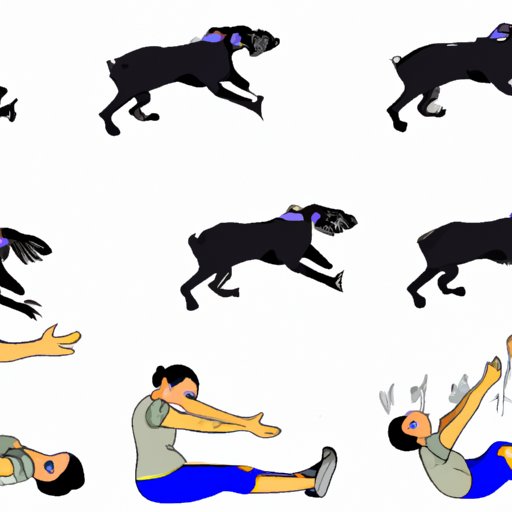Introduction
Dogs can become anxious for a variety of reasons. Anxiety in canines is usually caused by fear, excitement, or stress. It can manifest itself in physical symptoms such as trembling, panting, pacing, and barking. It is important to be able to recognize when your dog is feeling anxious, so that you can intervene and help them relax. In this article, we will explore different ways to calm your dog down, including exercise, desensitization, distraction, relaxation techniques, counterconditioning, and herbal remedies.
Exercise
Regular exercise is essential for keeping your dog healthy both physically and mentally. Taking your dog on regular walks and engaging in playtime activities can help reduce their anxiety levels. Exercise releases endorphins which can help reduce stress and improve overall wellbeing.
When taking your dog on walks, try to avoid areas that may trigger their anxiety. For example, if your dog is scared of other dogs, choose a route where there are not many other canines around. You should also keep your dog’s leash loose, so that they don’t feel restricted. If your dog enjoys playing fetch, try to find a large open space where they can run freely. This will give them an opportunity to release energy and have fun without being confined.
Desensitization
Desensitization is a process that involves gradually introducing your dog to stimuli that cause them anxiety. The goal is to help your dog become accustomed to the stimulus, so that it no longer causes them distress. To do this, you must start off by introducing the stimulus at a low intensity level. As your dog becomes more comfortable with the stimulus, you can gradually increase the intensity.
For example, if your dog is scared of loud noises, you can start off by playing recordings of thunderstorms at a low volume. Once your dog is no longer displaying signs of anxiety, you can gradually increase the volume. You should always reward your dog for displaying calm behavior, as this will reinforce positive behaviors.
Distraction
Providing your dog with toys and chews can be a great way to distract them from stressful situations. This can include anything from puzzles and treat dispensers to chew toys and interactive games. Playing these games can help redirect your dog’s attention away from their anxiety and onto something more enjoyable.
It is important to choose toys that are appropriate for your dog’s size and age. Some toys may be too big or too small, and some may not be suitable for puppies. You should also monitor your dog’s behavior while they are playing with the toys, to make sure they are not getting too excited or aggressive.
Relaxation Techniques
Deep breathing exercises can be a helpful tool for calming your dog down. Teaching your dog to take deep breaths can help them relax and focus on controlling their emotions. Start by having your dog sit or lay down in a quiet place. Then, slowly guide them through a few deep breaths. You can use a verbal cue such as “relax” or “calm down” to help them focus.
Once your dog is comfortable with deep breathing, you can introduce other relaxation techniques such as massage or meditation. Massage can help reduce stress and improve circulation, while meditation can help your dog become more aware of their body and environment. Both of these techniques can be beneficial for calming your dog down.
Counterconditioning
Counterconditioning is a training method that involves changing your dog’s emotional response to a certain stimulus. This can be done by rewarding your dog for displaying desired behaviors in the presence of the stimulus. For example, if your dog is scared of other dogs, you can reward them for displaying calm behavior when they encounter another canine. Over time, your dog will learn to associate the presence of other dogs with positive feelings.
In order for counterconditioning to be effective, you must provide consistent rewards for your dog’s desired behaviors. This could include treats, verbal praise, or even affection. The goal is to create a positive association between the stimulus and the reward, so that your dog will eventually respond positively to the stimulus.
Herbal Remedies
There are a number of natural remedies that can help reduce stress and anxiety in dogs. Herbal supplements such as chamomile, valerian root, and lavender can be beneficial for calming your dog down. These supplements can be added to your dog’s food or given as treats. However, it is important to talk to your vet before giving any type of supplement to your dog.
In addition to herbal supplements, there are also a number of essential oils that can help reduce anxiety in dogs. Lavender oil is one of the most popular options, as it has calming properties. You can diffuse the oil in your home, or apply a few drops to your dog’s collar. Just be sure to dilute the oil beforehand, as undiluted essential oils can be harmful to your pet.
Conclusion
Anxiety in dogs can be difficult to manage, but there are a number of strategies that can help calm your dog down. Exercise, desensitization, distraction, relaxation techniques, counterconditioning, and herbal remedies can all be effective methods for reducing anxiety in dogs. It is important to remember that each dog is unique, so you may need to experiment with different strategies to find what works best for your pet. With patience and consistency, you can help your dog lead a calmer, happier life.
(Note: Is this article not meeting your expectations? Do you have knowledge or insights to share? Unlock new opportunities and expand your reach by joining our authors team. Click Registration to join us and share your expertise with our readers.)
